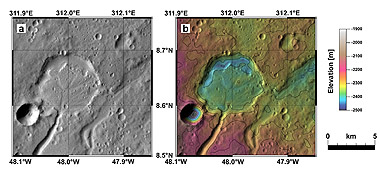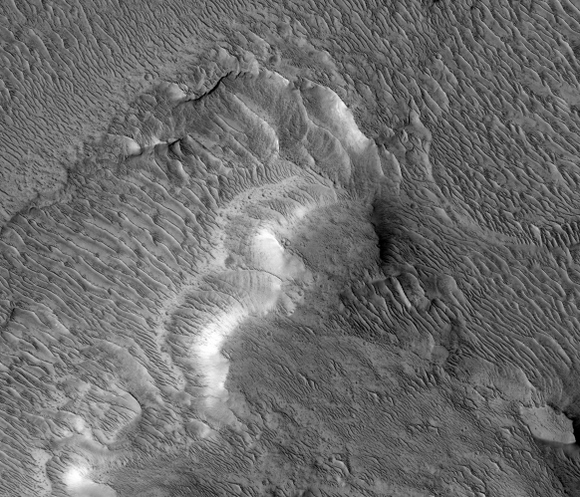[/caption]
Images of layered sedimentary deposits and deltas on Mars have provided evidence for lakes and flowing rivers that carried eroded material downstream. A team of researchers also believes there is evidence for precipitation in the Red Planet’s past. “For years scientists have been suspecting that the current appearance of the landscape has, in part, been shaped by rivers that cut into the surface,” said Ernst Hauber of the German Aerospace Center. “We can see layered sediments where these valleys open into impact craters. The shape of certain sediments is typical for deltas formed in standing water.” Hauber and his team also believe that surface runoff from rain or snowmelt completes the picture of past water on Mars.
The researchers explored the Xanthe Terra area located near the equator in the Martian highlands using image from four cameras on three different spacecraft; High-Resolution Stereo Camera (HRSC) on board the European Mars Express mission, the Mars Orbiter Camera (MOC) from NASA’s Mars Global Surveyor Mission and the HiRISE and CTX camera experiments on board NASA’s Mars Reconnaissance Orbiter (MRO) mission.

The images paint this picture of Mars’ past: About four billion years ago, there were lakes on the Red Planet which may have been fed by short-lived rivers that were, in turn, fed by precipitation. These lakes filled craters that were formed by the impact of meteorites. Water accumulated in places where rivers broke through the crater rims. Deltas were formed at the mouths of the rivers, similar to how they are formed where rivers flow into lakes or seas on Earth.

The researchers say were also able to narrow down the period when the craters were filled with lakes by analyzing the distribution of impact craters of different sizes, which gives an indication of the age of a planetary surface. The more craters are counted on a surface, the older the area is. The crater counts revealed that water was flowing through the valleys between about 3.8 and 4 billion years ago.
The valleys themselves could have formed relatively fast, and the deposits could have formed over a period ranging from decades to millennia.
But what led the researchers to surmise that there must have been precipitation on early Mars? “This is actually not at all self-evident: for a long time, scientists have been trying to figure out whether the valleys on Mars were formed by groundwater seepage and headward erosion, or by surface runoff caused by rainfall or snowmelt”, said Hauber. His team believes surface runoff was the cause. “Our findings also point in this direction and we are convinced that both processes have played an important role in Xanthe Terra”.
However, this situation did not last very long. Between 3.5 and 3.8 billion years ago, the precipitation became less intense and the valleys dried up. Erosion on Mars has been minimal ever since, which has contributed to the fact that deposits can still be observed although they should in fact be very susceptible to erosion. Today, Mars is a dry desert planet and water is no longer flowing through its valleys.
Source: German Aerospace Center


Just a thought, and in no way am I a conspiracy therorist, but I find it odd, and at the least somewhat patronizing, that the article would read that, “Today, Mars is a dry desert planet and water is no longer flowing through its valleys.” As though we don’t know this. Perhaps this was said for simplicity sake, but as someone who has worked in the behavioral health field for some time, this seems more like the comment of someone who is making sure that a statement is made that will devert any question of an opposing matter. For what reason, it’s obviously not clear, but perhaps just something to think about…or not.
Much Peace!
Will
“this seems more like the comment of someone who is making sure that a statement is made that will devert any question of an opposing matter.”
I think it is more likely a statement to make sure that people are clear that they are talking about water in the distant past, and not the present. You might be surprised how many people think Mars’s climate is a lot like the Earth’s.
But the real answer is to revert to the classic books on survival in any desert. Where there are valley floors, where you will discover that on every part of this planet there are desert communities. When you dig into a desert valley floor you find water. A very good example is the Sahara Desert where they pump out water billions of years old from deep aquifers. Water might not have flowed on Mars for 4 billion years, but I will bet my right arm it exists in large quantities deep below the surface and that, in the valley floors, it may be close enough to the surface to be relatively easily accessible.